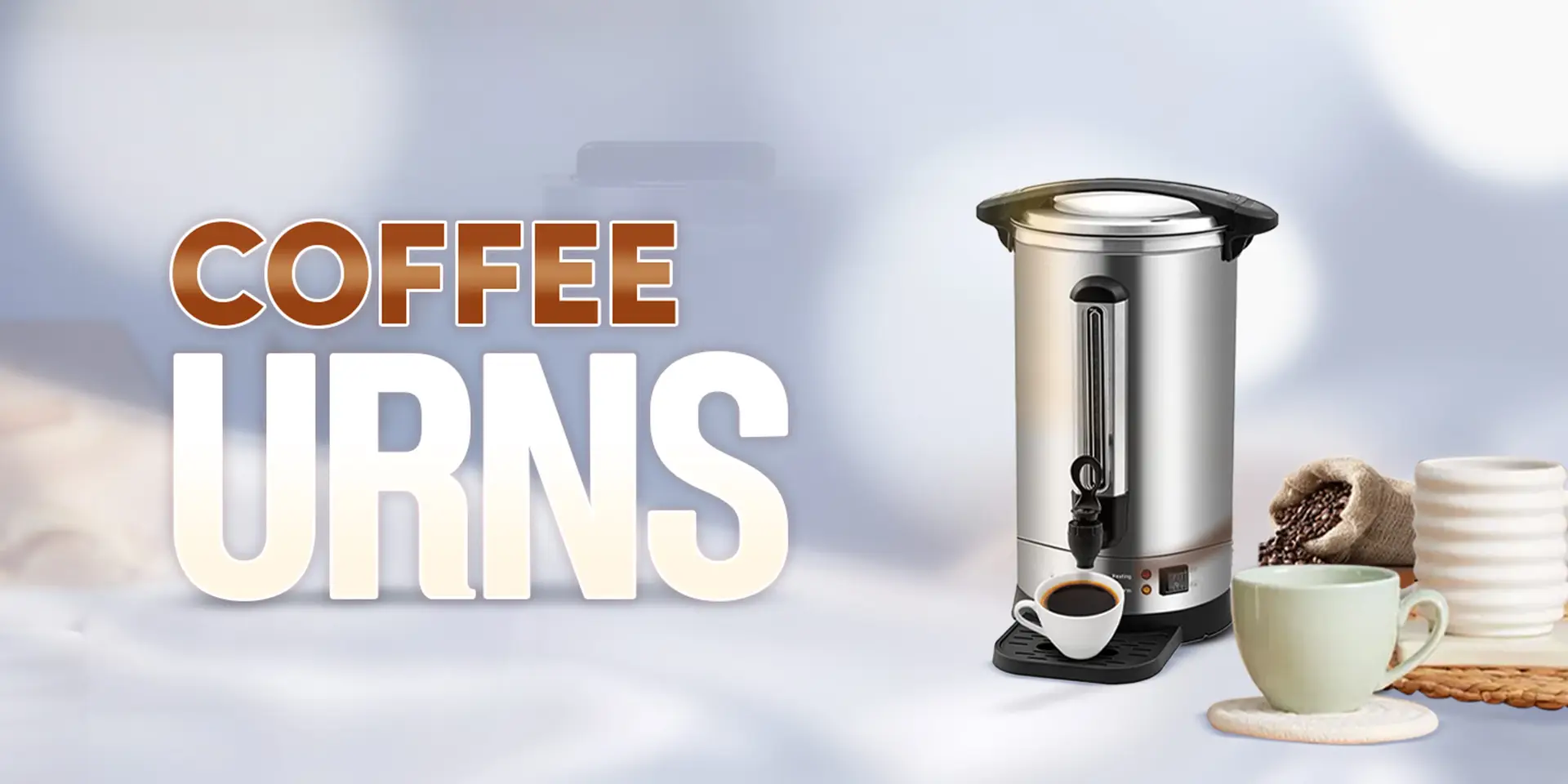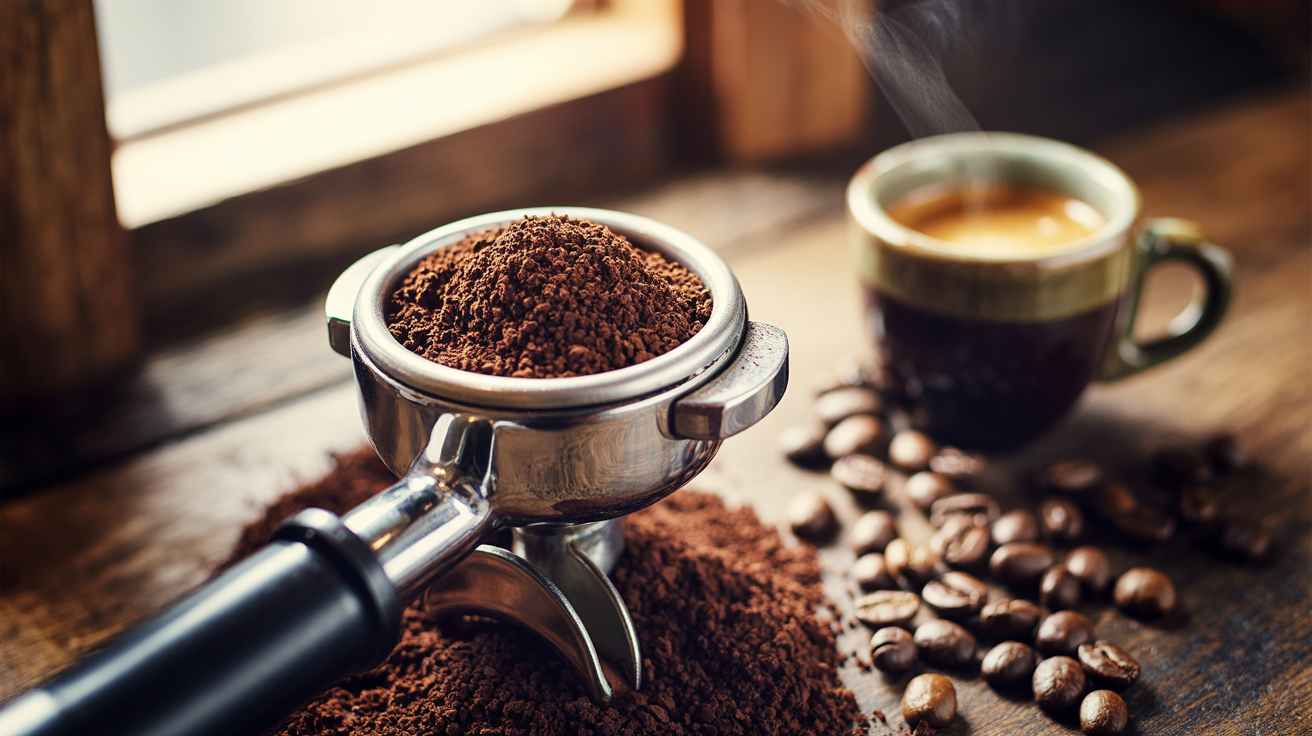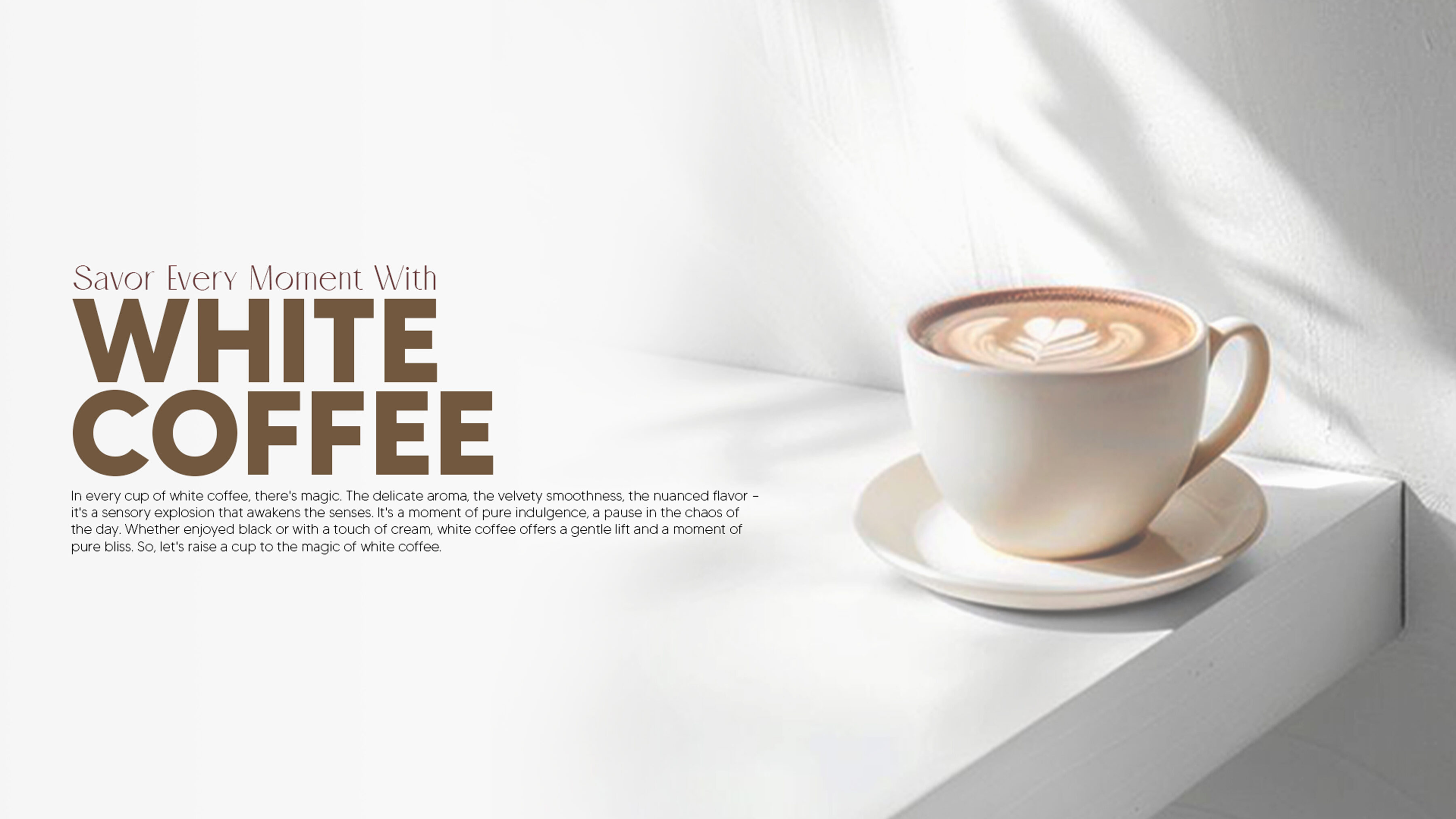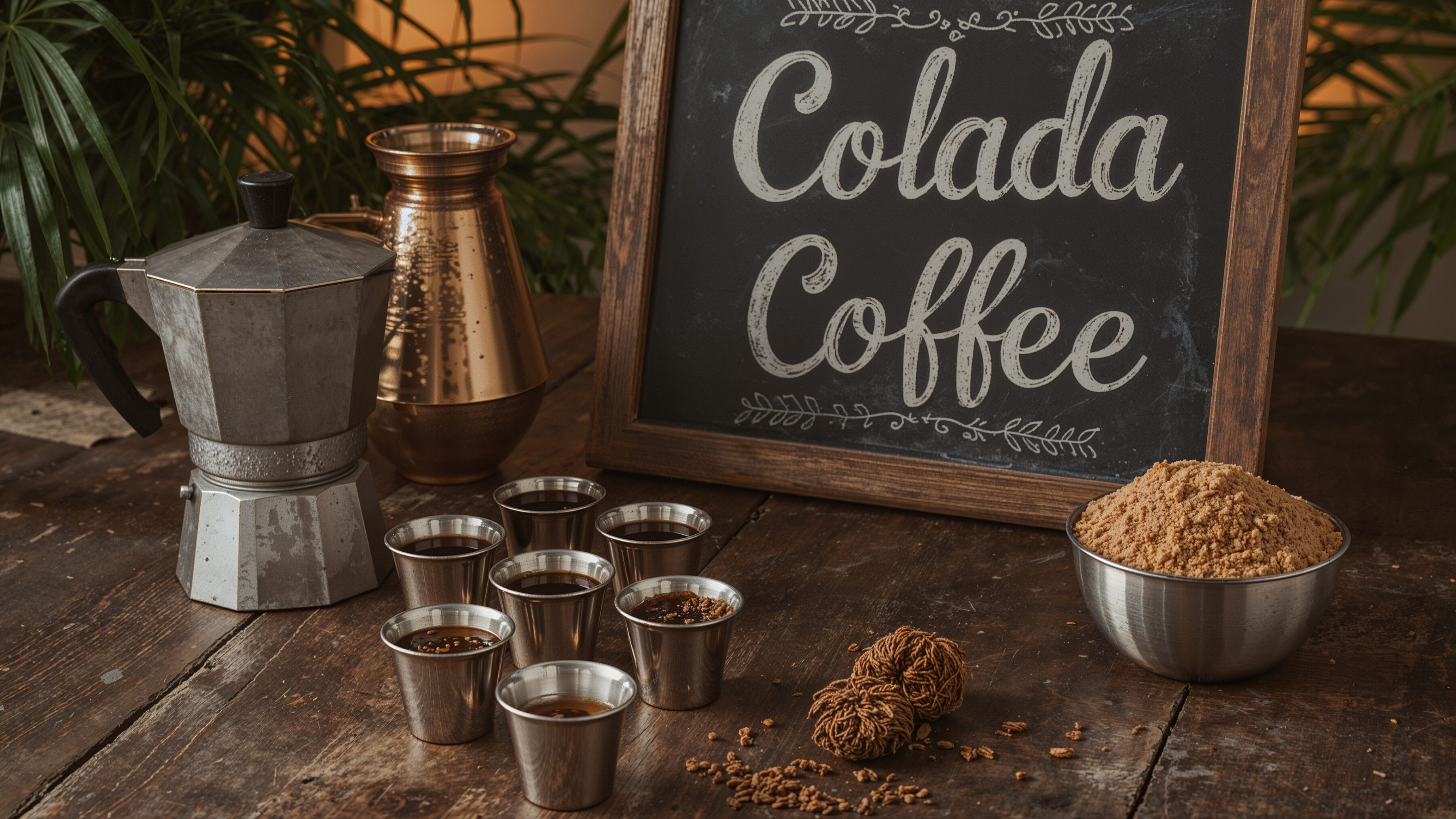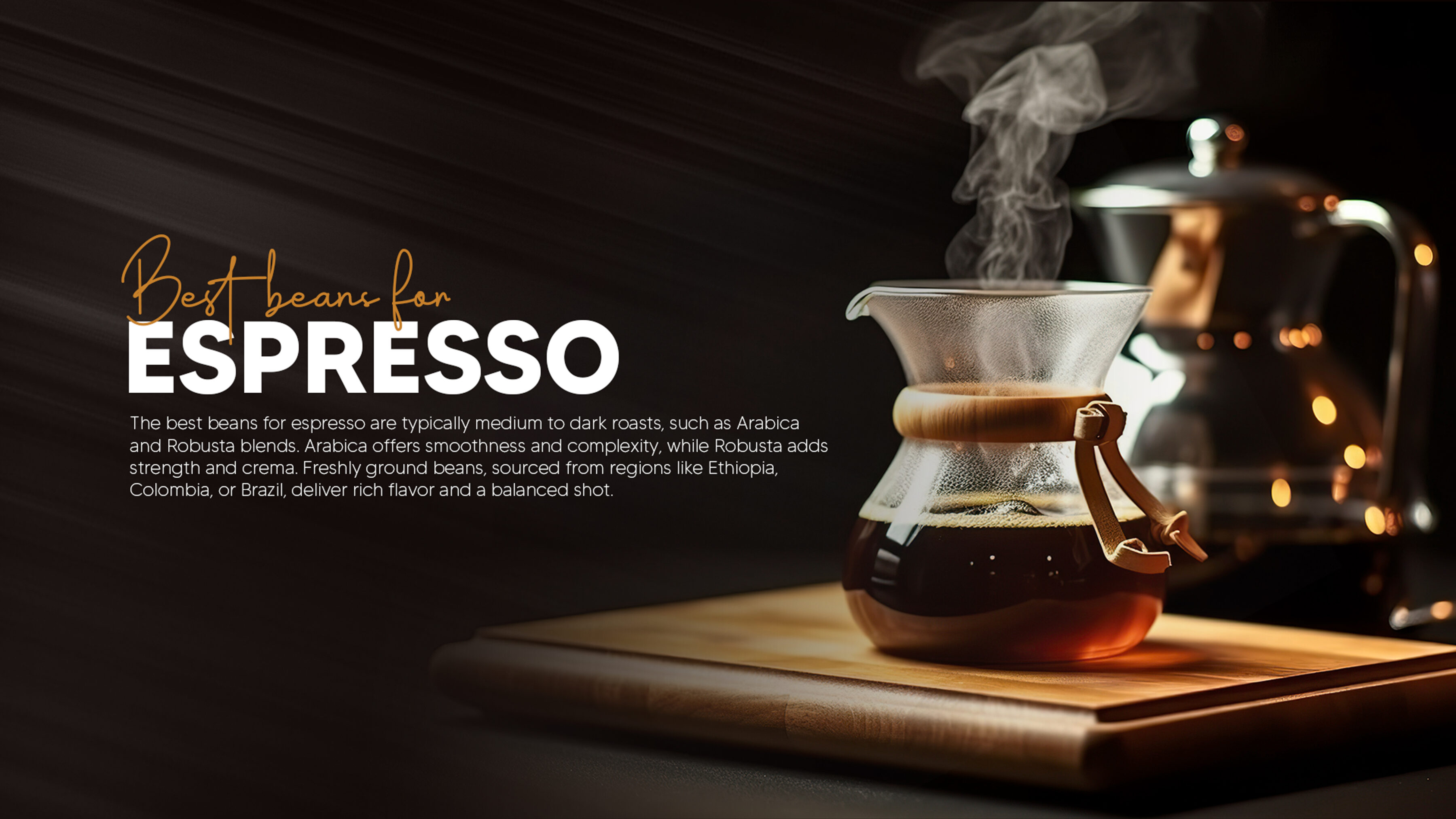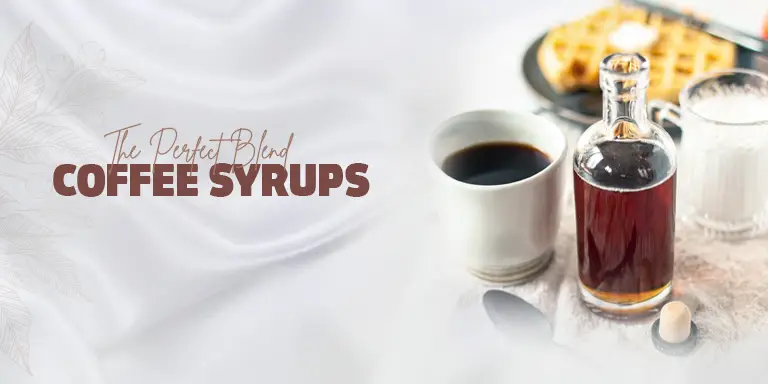5 Surprising Benefits of Drinking Breve Coffee Daily 5 Surprising Benefits of Drinking Breve Coffee Daily Introduction Briefly introduce what...
Read MoreCarbs in Coffee: What You Need to Know Before Your Next Cup

Carbs in Coffee: What You Need to Know Before Your Next Cup


1. What Are Carbs in Coffee?
Define carbohydrates in the context of beverages.
Understanding the Carbs in Coffee: A Key to Empowerment. Carbohydrates in beverages: What are they? They are the primary source of energy, often sugars, e.g., sucrose, fructose, and glucose, which are key components of many beverages. Think sugary sodas and sweetened fruit juices, and don’t shoot the messenger sweetened teas; these are among the best sources. But what, exactly, are the carbs in coffee? Black coffee, plain and unsweet, has nearly negligible amounts of them. With additives, the narrative is completely different. It is the added milk, sugar, and flavored syrups that make it high in carbohydrates. This just highlights for me how important it is to know what is made up of carbohydrates in anything we drink. By understanding the carb content in coffee, you can make informed choices and take control of your dietary habits.
Talk about low-carb and keto lifestyles.
The low-carb and keto lifestyles are popular diets that change macronutrient consumption and have a huge limit on carbs. Low-carb living tends to restrict them. The ketogenic (“keto”) diet is an extremely high-fat diet that forces your body to convert glucose into ketone bodies, a fuel source it’s naturally designed to use; this is a process that generally takes a few days of eating almost no carbohydrates to achieve. Many experience these lifestyles for dramatic weight loss, mental sharpness, or better blood sugar management. Despite these strict constraints, success involves adopting all manner of drastic dietary changes, with fats and proteins displacing the bulk of calories one used to take in from carbs, and even the most thought-through plans still sometimes require added restrainers for long-term health, nutrient needs, and sustainability.
2. How Many Carbs in Coffee? Let's Break It Down
Brewed drip coffee
The process of brewing drip coffee is simple and easy, which is why it’s wildly popular. Its hot water slowly seeps through ground coffee beans that are held in a filter, and it produces a clean cup of coffee. When we talk about varieties of coffee, the good old drip is popular for its ease and comforting flavor. It’s loved for its flavor, which is very well-balanced by many. This approach is at odds with immersion methods such as a French press or concentrated shots like espresso, which deliver different textures and intensities. And so, drip-brewed coffee continues to be the drink of choice for everyday indulgence a cornerstone in the vast statement of coffee drinks and epitomizing unique brew characteristics.
Instant coffee
Quick coffee is an incredibly easy choice for a quick caffeine shot. This beloved drink is basically coffee that has been dehydrated and turned into soluble crystals or powder that can be reconstituted in an instant. So, when it comes to the question of “How Many Carbs in Coffee?, such a low number for instant coffee is a promising sign. Unsweetened instant coffee (when mixed with hot water alone) has virtually no carbs, but there are carbs in regular black, brewed coffee. The only time the carbohydrate that can be found in an instant coffee drink increases is when sugar, milk, creamers, or flavored syrups are added to your instant coffee beverage. This difference is crucial when it comes to the control of carb intake.
Espresso
Espresso, the strong brewed coffee drink, is a drink made from pushing very hot water through some finely-ground coffee beans. So, how many carbs does an espresso have in coffee? Fortunately, straight espresso is very low in carbs; some (100) may even say zero almost! This is fantastic news. It has relatively few carbs, making it a smart choice if you’re keeping an eye on your intake. Remember, the carbs in coffee-based drinks are usually introduced in the form of milk, sugar, or flavored syrups and don’t come directly from the espresso. As a result, a straight shot is still almost completely carb-free without any fat or protein, which is a vital piece of information for health-conscious coffee drinkers.
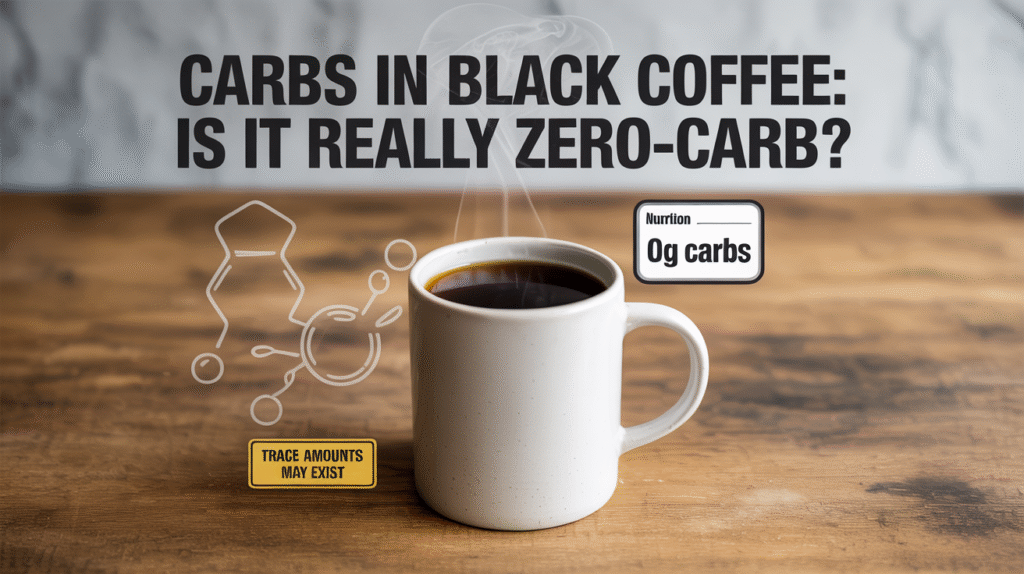
3. Carbs in Black Coffee: Is It Really Zero-Carb?
Clarify common myths about black coffee and its carb content.
Let’s clear up some of the misconceptions related to black coffee and carbs. One of the common questions that pops into your mind is: Are carbs in black coffee? Is it really zero-carb up, by the way? For any kind of “real-world” dietary tracking, that is a massive yes. Although the coffee bean technically contains an inconceivably insignificant trace amount of carbs, any such amount would be negligible enough to where the carb content is so low, usually less than a single gram per typical cup, as to have no nutritional impact. Thus, it is quite accurately rounded to zero. This is what makes pure black coffee such an awesome, almost carb-free option, and it debunks any idea of it having secret sugars in it. It’s a very friendly option.
Explain trace carb presence in certain brewing methods.
Trace Carb Content In Some Brewing Methods Explained: although trace, the question, “Carbs In Black Coffee: Is It Really Zero-Carb?” is occasionally because of these small quantities. Some brewing methods, such as a longer steep in a French press or unfiltered methods that allow more small particles through, could theoretically extract vanishingly small amounts of such compounds from the coffee bean itself. Such quantities are generally considered to be nutritionally insignificant. The big picture of Carbs in Coffee is that, for most practical dietary purposes, coffee is and continues to be essentially a zero-carb drink in spite of these hyper-trace possibilities brought about by some brewing methods. This is not a detail to be concerned about.
4. Carbs in Coffee Creamer: The Hidden Sugar Bomb
Compare flavored creamers, dairy-based vs. non-dairy, sugar-free versions.
Compare Flavored Creamers, Dairy vs. Non-Dairy, Flavors, Best Sugar-Free Versions: Expl inside & out, why the need to know of carbs in coffee creamer: hidden sugar bomb lurking withIN! Conventional creamers made with dairy, especially flavored kinds, can be loaded with sugar and carbs. There are plenty of non-dairy alternatives, like those made from soy, almonds, or oats, and many of those can be high in carbs, depending on added sweeteners. However, there are sugar-free and low-carb options in both dairy and non-dairy options that use non-caloric sweeteners. (Always read labels; “sugar-free” does not always mean zero carbs, though it’s usually far, far lower in carbs and better for controlling sugar intake.)
Include a product comparison table (e.g., Coffee-Mate vs. almond milk creamer).
In Rose Otte’s world of coffee additions, a product comparison chart can really come in handy. For example, placing Coffee Mate next to an almond milk creamer side-by-side on a table can speak volumes. So why is the picture necessary? It shines a light on the “carbs in coffee creamer: the hidden sugar bomb” by serving up the sugar, fat, and total carbs per serving! This gives you the power to make the best decisions about what you put inside your body – whether you’re going for low carb, avoiding I-named chemicals, or any other dietary preference. These comparisons also demystify nutrition labels.
5. Best Low-Carb Coffee Choices for Keto & Diabetic Diets
Unsweetened almond milk
Unsweetened almond milk is also another great low-carb drink base and is a favorite among the more strict dieters alcohol-beverage-wise. Definitely one of the best keto & diabetic low-carb coffee options when it comes to low carbohydrate and sugar content. This dairy-free version delivers creaminess to coffee while affecting blood sugar levels and daily carb consumption very little. Many people love it. It’s like water, except it has the metabolism-boost of coffee, and it’s a healthy, natural, low-calorie way to drink so much coffee that you forget about food. Indeed, unsweetened almond milk is a great, health-conscious option to take your coffee to the next level without all of the added sugars or carbs.
Stevia or monk fruit sweeteners
Stevia or monk fruit is best to keep Carbs in Coffee in check. Don’t forget, they add a sweet taste with very little effect on your carbohydrate consumption. This makes them among the best low-carb coffee choices for keto & diabetic diets in which getting command sugar is a priority. These naturally sweet, no-calorie additions are the perfect way to sip a little sweeter. Importantly, Stecia and monk fruit have a significant effect on blood glucose levels. Enjoying them also means you have the freedom to adjust the taste of your coffee without all the sugars and carbs that are often found in sugar or many traditional creamers, which makes all the difference to your health-focused aspirations. They have a genuinely smart answer.

6. How to Read Coffee Labels for Carb Content
Teach users how to identify carbs on nutrition labels.
Make sure they know how to find carbs on nutrition labels. They’ll need to be able to do this throughout life. When you are monitoring what you consume, finding out how to read coffee labels to get the carb content is invaluable. Find the “Nutrition Facts” panel. The most important line is Total Carbohydrate, which reports the total carb grams per serving. You’ll often find “Dietary Fiber” and/or “Total Sugars.” (And, let’s not forget, fiber doesn’t usually make a big difference to blood sugar.) Notice “Added Sugars,” the sugars that are often hidden in coffee creamers and premade drinks. The signal provides us with information that helps us to make better health-related choices.
Explain total carbs vs. net carbs.
It is essential to understand how to read coffee labels for carbs if you are managing your Carbs in Coffee wisely. Read the ”Nutrition Facts” panel on packaged coffee products or creamers. That’s where you’ll see it under “Total Carbohydrate,” a number you are supposed to divide by the number of servings in the package to get the amount for a serving. “Dietary Fiber and Total Sugars” contain these useful details under this information. Explanation of total carbs vs. net carbs: Total carbohydrates include all carbs. Net carbs, though (total carbs minus fiber, and sometimes certain sugar alcohols), are technically about digestible carbs, which are more likely to affect blood sugar, which is a helpful distinction to make when you are doing keto. It’s helpful to know this because it will demystify those numbers.
7. Expert Opinions and Real-Life Insights
Coffee experts or baristas
Coffee professionals Navigating the world of coffee can be a daunting task, yet coffee experts and baristas have mastered the art well. Their expertise runs much deeper than simply pulling the perfect espresso shot. These pros share their expertise and real-world experiences on everything from where beans come from and how they’re roasted to the best way to brew them. They can take the mystery out of coffee terminology. Asking for their help often results in special preparations or just an opportunity for customers to discover a great drink that suits their taste, and it’s possible, if you are into hidden carbs or sugar, to be steered clear based on your choices. Indeed, their enthusiasm really does come through in a lot of good, useful information.
Keto influencers
Keto influencers have emerged as legitimate voices, providing a mix of expert opinion and personal experience when it comes to the keto diet. Their platforms are popular. Followers frequently look to them for practical strategies, including how to figure out the occasionally baffling world of the Carbs in Coffee. Those personalities may talk about how to get away with drinking coffee without sabotaging ketosis, promoting low-carb sweeteners or creamers, and cautioning about sugary satisfied you, and they lead to fat loss. They share what works. This common-sense advice offers real-world guidance for getting the most out of your ketogenic lifestyle and setting your own drinking benchmarks.
Basically, knowing the carbs in coffee comes down to one simple fact. Your plain black coffee? It is gloriously, almost entirely, carbohydrate-free, a spectacular option. This is great news. But where the carbs in coffee become fascinating is when you begin to add things to it. Milk and sugars and those seductive flavored creamers can send the carb total soaring often to a point that surpasses expectations. Vigilance is, therefore , the key. Just always read the nutrition labels on any add-ins to really be aware of how many carbs are in your coffee cup so that you can make healthy choices and not have to deprive yourself on a daily basis.
Popular Posts
Cortadito Coffee: A Sweet, Bold Cuban Espresso Drink
Cortadito Coffee: Why This Cuban Drink Should Be Your Next Favorite Cortadito Coffee: Why This Cuban Drink Should Be Your...
Read MoreCoffee Urns: Perfect for Brewing Large Quantities of Coffee
Coffee Urn: Elevate Your Gathering with Perfectly Brewed Coffee! Coffee Urn: Elevate Your Gathering with Perfectly Brewed Coffee! I. Introduction...
Read MoreThe Ultimate Guide to Perfect Espresso Grounds
The Ultimate Guide to Perfect Espresso Grounds The Ultimate Guide to Perfect Espresso Grounds Introduction: Mastering Espresso Grounds for Great...
Read MoreAmaretto Coffee: A Sweet, Nutty Twist on Your Favorite Brew
How to Make the Best Amaretto Coffee: Delicious Recipes & Syrup Guide How to Make the Best Amaretto Coffee: Delicious...
Read MoreWhite Coffee: The Unique Brew You Need to Try Today
Experience the Smooth Taste of White Coffee: Your New Favorite Drink! Experience the Smooth Taste of White Coffee: Your New...
Read More
1. What Are Carbs in Coffee?
Define carbohydrates in the context of beverages.
Understanding the Carbs in Coffee: A Key to Empowerment. Carbohydrates in beverages: What are they? They are the primary source of energy, often sugars, e.g., sucrose, fructose, and glucose, which are key components of many beverages. Think sugary sodas and sweetened fruit juices, and don’t shoot the messenger sweetened teas; these are among the best sources. But what, exactly, are the carbs in coffee? Black coffee, plain and unsweet, has nearly negligible amounts of them. With additives, the narrative is completely different. It is the added milk, sugar, and flavored syrups that make it high in carbohydrates. This just highlights for me how important it is to know what is made up of carbohydrates in anything we drink. By understanding the carb content in coffee, you can make informed choices and take control of your dietary habits.
Talk about low-carb and keto lifestyles.
The low-carb and keto lifestyles are popular diets that change macronutrient consumption and have a huge limit on carbs. Low-carb living tends to restrict them. The ketogenic (“keto”) diet is an extremely high-fat diet that forces your body to convert glucose into ketone bodies, a fuel source it’s naturally designed to use; this is a process that generally takes a few days of eating almost no carbohydrates to achieve. Many experience these lifestyles for dramatic weight loss, mental sharpness, or better blood sugar management. Despite these strict constraints, success involves adopting all manner of drastic dietary changes, with fats and proteins displacing the bulk of calories one used to take in from carbs, and even the most thought-through plans still sometimes require added restrainers for long-term health, nutrient needs, and sustainability.
2. How Many Carbs in Coffee? Let's Break It Down
Brewed drip coffee
The process of brewing drip coffee is simple and easy, which is why it’s wildly popular. Its hot water slowly seeps through ground coffee beans that are held in a filter, and it produces a clean cup of coffee. When we talk about varieties of coffee, the good old drip is popular for its ease and comforting flavor. It’s loved for its flavor, which is very well-balanced by many. This approach is at odds with immersion methods such as a French press or concentrated shots like espresso, which deliver different textures and intensities. And so, drip-brewed coffee continues to be the drink of choice for everyday indulgence a cornerstone in the vast statement of coffee drinks and epitomizing unique brew characteristics.
Instant coffee
Quick coffee is an incredibly easy choice for a quick caffeine shot. This beloved drink is basically coffee that has been dehydrated and turned into soluble crystals or powder that can be reconstituted in an instant. So, when it comes to the question of “How Many Carbs in Coffee?, such a low number for instant coffee is a promising sign. Unsweetened instant coffee (when mixed with hot water alone) has virtually no carbs, but there are carbs in regular black, brewed coffee. The only time the carbohydrate that can be found in an instant coffee drink increases is when sugar, milk, creamers, or flavored syrups are added to your instant coffee beverage. This difference is crucial when it comes to the control of carb intake.
Espresso
Espresso, the strong brewed coffee drink, is a drink made from pushing very hot water through some finely-ground coffee beans. So, how many carbs does an espresso have in coffee? Fortunately, straight espresso is very low in carbs; some (100) may even say zero almost! This is fantastic news. It has relatively few carbs, making it a smart choice if you’re keeping an eye on your intake. Remember, the carbs in coffee-based drinks are usually introduced in the form of milk, sugar, or flavored syrups and don’t come directly from the espresso. As a result, a straight shot is still almost completely carb-free without any fat or protein, which is a vital piece of information for health-conscious coffee drinkers.

3. Carbs in Black Coffee: Is It Really Zero-Carb?
Clarify common myths about black coffee and its carb content.
Let’s clear up some of the misconceptions related to black coffee and carbs. One of the common questions that pops into your mind is: Are carbs in black coffee? Is it really zero-carb up, by the way? For any kind of “real-world” dietary tracking, that is a massive yes. Although the coffee bean technically contains an inconceivably insignificant trace amount of carbs, any such amount would be negligible enough to where the carb content is so low, usually less than a single gram per typical cup, as to have no nutritional impact. Thus, it is quite accurately rounded to zero. This is what makes pure black coffee such an awesome, almost carb-free option, and it debunks any idea of it having secret sugars in it. It’s a very friendly option.
Explain trace carb presence in certain brewing methods.
Trace Carb Content In Some Brewing Methods Explained: although trace, the question, “Carbs In Black Coffee: Is It Really Zero-Carb?” is occasionally because of these small quantities. Some brewing methods, such as a longer steep in a French press or unfiltered methods that allow more small particles through, could theoretically extract vanishingly small amounts of such compounds from the coffee bean itself. Such quantities are generally considered to be nutritionally insignificant. The big picture of Carbs in Coffee is that, for most practical dietary purposes, coffee is and continues to be essentially a zero-carb drink in spite of these hyper-trace possibilities brought about by some brewing methods. This is not a detail to be concerned about.
4. Carbs in Coffee Creamer: The Hidden Sugar Bomb
Compare flavored creamers, dairy-based vs. non-dairy, sugar-free versions.
Compare Flavored Creamers, Dairy vs. Non-Dairy, Flavors, Best Sugar-Free Versions: Expl inside & out, why the need to know of carbs in coffee creamer: hidden sugar bomb lurking withIN! Conventional creamers made with dairy, especially flavored kinds, can be loaded with sugar and carbs. There are plenty of non-dairy alternatives, like those made from soy, almonds, or oats, and many of those can be high in carbs, depending on added sweeteners. However, there are sugar-free and low-carb options in both dairy and non-dairy options that use non-caloric sweeteners. (Always read labels; “sugar-free” does not always mean zero carbs, though it’s usually far, far lower in carbs and better for controlling sugar intake.)
Include a product comparison table (e.g., Coffee-Mate vs. almond milk creamer).
In Rose Otte’s world of coffee additions, a product comparison chart can really come in handy. For example, placing Coffee Mate next to an almond milk creamer side-by-side on a table can speak volumes. So why is the picture necessary? It shines a light on the “carbs in coffee creamer: the hidden sugar bomb” by serving up the sugar, fat, and total carbs per serving! This gives you the power to make the best decisions about what you put inside your body – whether you’re going for low carb, avoiding I-named chemicals, or any other dietary preference. These comparisons also demystify nutrition labels.
5. Best Low-Carb Coffee Choices for Keto & Diabetic Diets
Unsweetened almond milk
Unsweetened almond milk is also another great low-carb drink base and is a favorite among the more strict dieters alcohol-beverage-wise. Definitely one of the best keto & diabetic low-carb coffee options when it comes to low carbohydrate and sugar content. This dairy-free version delivers creaminess to coffee while affecting blood sugar levels and daily carb consumption very little. Many people love it. It’s like water, except it has the metabolism-boost of coffee, and it’s a healthy, natural, low-calorie way to drink so much coffee that you forget about food. Indeed, unsweetened almond milk is a great, health-conscious option to take your coffee to the next level without all of the added sugars or carbs.
Stevia or monk fruit sweeteners
Stevia or monk fruit is best to keep Carbs in Coffee in check. Don’t forget, they add a sweet taste with very little effect on your carbohydrate consumption. This makes them among the best low-carb coffee choices for keto & diabetic diets in which getting command sugar is a priority. These naturally sweet, no-calorie additions are the perfect way to sip a little sweeter. Importantly, Stecia and monk fruit have a significant effect on blood glucose levels. Enjoying them also means you have the freedom to adjust the taste of your coffee without all the sugars and carbs that are often found in sugar or many traditional creamers, which makes all the difference to your health-focused aspirations. They have a genuinely smart answer.

6. How to Read Coffee Labels for Carb Content
Teach users how to identify carbs on nutrition labels.
Make sure they know how to find carbs on nutrition labels. They’ll need to be able to do this throughout life. When you are monitoring what you consume, finding out how to read coffee labels to get the carb content is invaluable. Find the “Nutrition Facts” panel. The most important line is Total Carbohydrate, which reports the total carb grams per serving. You’ll often find “Dietary Fiber” and/or “Total Sugars.” (And, let’s not forget, fiber doesn’t usually make a big difference to blood sugar.) Notice “Added Sugars,” the sugars that are often hidden in coffee creamers and premade drinks. The signal provides us with information that helps us to make better health-related choices.
Explain total carbs vs. net carbs.
It is essential to understand how to read coffee labels for carbs if you are managing your Carbs in Coffee wisely. Read the ”Nutrition Facts” panel on packaged coffee products or creamers. That’s where you’ll see it under “Total Carbohydrate,” a number you are supposed to divide by the number of servings in the package to get the amount for a serving. “Dietary Fiber and Total Sugars” contain these useful details under this information. Explanation of total carbs vs. net carbs: Total carbohydrates include all carbs. Net carbs, though (total carbs minus fiber, and sometimes certain sugar alcohols), are technically about digestible carbs, which are more likely to affect blood sugar, which is a helpful distinction to make when you are doing keto. It’s helpful to know this because it will demystify those numbers.
7. Expert Opinions and Real-Life Insights
Coffee experts or baristas
Coffee professionals Navigating the world of coffee can be a daunting task, yet coffee experts and baristas have mastered the art well. Their expertise runs much deeper than simply pulling the perfect espresso shot. These pros share their expertise and real-world experiences on everything from where beans come from and how they’re roasted to the best way to brew them. They can take the mystery out of coffee terminology. Asking for their help often results in special preparations or just an opportunity for customers to discover a great drink that suits their taste, and it’s possible, if you are into hidden carbs or sugar, to be steered clear based on your choices. Indeed, their enthusiasm really does come through in a lot of good, useful information.
Keto influencers
Keto influencers have emerged as legitimate voices, providing a mix of expert opinion and personal experience when it comes to the keto diet. Their platforms are popular. Followers frequently look to them for practical strategies, including how to figure out the occasionally baffling world of the Carbs in Coffee. Those personalities may talk about how to get away with drinking coffee without sabotaging ketosis, promoting low-carb sweeteners or creamers, and cautioning about sugary satisfied you, and they lead to fat loss. They share what works. This common-sense advice offers real-world guidance for getting the most out of your ketogenic lifestyle and setting your own drinking benchmarks.
Basically, knowing the carbs in coffee comes down to one simple fact. Your plain black coffee? It is gloriously, almost entirely, carbohydrate-free, a spectacular option. This is great news. But where the carbs in coffee become fascinating is when you begin to add things to it. Milk and sugars and those seductive flavored creamers can send the carb total soaring often to a point that surpasses expectations. Vigilance is, therefore , the key. Just always read the nutrition labels on any add-ins to really be aware of how many carbs are in your coffee cup so that you can make healthy choices and not have to deprive yourself on a daily basis.
Popular Posts
Amaretto Coffee: A Sweet, Nutty Twist on Your Favorite Brew
How to Make the Best Amaretto Coffee: Delicious Recipes & Syrup Guide How to Make the Best Amaretto Coffee: Delicious...
Read MoreColada Coffee: A Bold Cuban Espresso Drink
Colada Coffee – Cuban Tradition in a Cup | How to Make It Right Colada Coffee – Cuban Tradition in...
Read MoreSugar Free Syrups: Sweeten Your Drinks Without the Calories
Sugar Free Syrup: Healthier Alternatives for Sweetening Your Drinks Sugar Free Syrup: Healthier Alternatives for Sweetening Your Drinks 1. Introduction:...
Read MoreEspresso Beans: Find the Best Beans for Perfect Espresso
Boost Your Day with Instant Espresso: Quick & Delicious! Boost Your Day with Instant Espresso: Quick & Delicious! Introduction A...
Read MoreBest Coffee Syrups to Enhance Your Espresso and Lattes
Coffee Syrups: Discover the Best Flavors to Elevate Your Morning Brew! Coffee Syrups: Discover the Best Flavors to Elevate Your...
Read MoreDecaf Coffee: Enjoy Rich Flavor Without the Caffeine Jitters
Health Benefits of Decaf Coffee: A Smarter Way to Enjoy Your Brew Health Benefits of Decaf Coffee: A Smarter Way...
Read More



